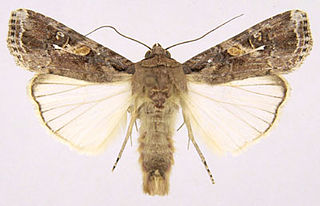| Sf caspase-1 | |||||||
|---|---|---|---|---|---|---|---|
 Sf caspase-1 structure by Ni et al. 2006 | |||||||
| Identifiers | |||||||
| Organism | |||||||
| Symbol | N/A | ||||||
| PDB | 2NN3 ( ECOD ) | ||||||
| RefSeq (mRNA) | U81510.1 | ||||||
| RefSeq (Prot) | AAC47442.1 | ||||||
| UniProt | P89116 | ||||||
| |||||||
The protein Sf caspase-1 is the insect ortholog of the human effector caspases CASP3 (CPP32) and CASP7 (MCH3) in the species Spodoptera frugiperda (Fall armyworm). [1] [2] It was identified as the target of the baculoviral caspase inhibitor protein P35, which it cleaves and by which it is inhibited. [1] Like other caspases, Sf caspase-1 is an aspartate-specific cysteine protease that is produced as an inactive proenzyme and becomes activated by autocatalytic cleavage. [1] The Sf caspase-1 proenzyme is cleaved after the amino acid residues Asp-28 and Asp-195, resulting in a smaller 12 kDa fragment and a larger 19 kDa fragment. [1] [2] Just like with human caspases CASP3 or CASP7, the two cleavage fragments form heterodimers, which again form biologically active dimers-of-heterodimers consisting of two smaller and two larger fragments. [2] Some experiments also showed cleavage of Sf caspase-1 at the residue Asp-184, resulting in an 18 kDa instead of 19 kDa fragment, however this result is likely an in vitro artefact. [2] The insect immunophilin FKBP46 is a substrate of Sf caspase-1, which cleaves full length FKBP46 (~46 kDa) resulting in a ~25 kDa fragment. [1]

The fall armyworm is a species in the order of Lepidoptera and is the larval life stage of a fall armyworm moth. The term "armyworm" can refer to several species, often describing the large-scale invasive behavior of the species' larval stage. It is regarded as a pest and can damage and destroy a wide variety of crops, which causes large economic damage. Its scientific name derives from frugiperda, which is Latin for lost fruit, named because of the species' ability to destroy crops. Because of its propensity for destruction, the fall armyworm's habits and possibilities for crop protection have been studied in depth. It is also a notable case for studying sympatric speciation, as it appears to be diverging into two species currently. Another remarkable trait of the larva is that they practice cannibalism.
The inhibitor protein (IP) is situated in the mitochondrial matrix and protects the cell against rapid ATP hydrolysis during momentary ischaemia. In oxygen absence, the pH of the matrix drops. This causes IP to become protonated and change its conformation to one that can bind to the F1Fo synthetase and stops it thereby preventing it from moving in a backwards direction and hydrolyze ATP instead of make it. When oxygen is finally incorporated into the system, the pH rises and IP is deprotonated. IP dissociates from the F1Fo synthetase and allows it to resume its ATP synthesis.

The Early 35 kDa protein, or P35 in short, is a baculoviral protein that inhibits apoptosis in the cells infected by the virus. Although baculoviruses infect only invertebrates in nature, ectopic expression of P35 in vertebrate animals and cells also results in inhibition of apoptosis, thus indicating a universal mechanism. P35 has been shown to be a caspase inhibitor with a very wide spectrum of activity both in regard to inhibited caspase types and to species in which the mechanism is conserved.
















